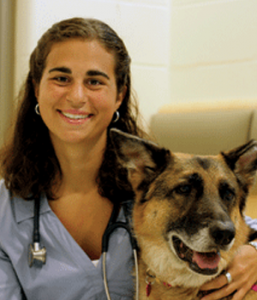-
Adopt
-
Veterinary Care
Services
Client Information
- What to Expect – Angell Boston
- Client Rights and Responsibilities
- Payments / Financial Assistance
- Pharmacy
- Client Policies
- Our Doctors
- Grief Support / Counseling
- Directions and Parking
- Helpful “How-to” Pet Care
Online Payments
Referrals
- Referral Forms/Contact
- Direct Connect
- Referring Veterinarian Portal
- Clinical Articles
- Partners in Care Newsletter
CE, Internships & Alumni Info
CE Seminar Schedule
Emergency: Boston
Emergency: Waltham
Poison Control Hotline
-
Programs & Resources
- Careers
-
Donate Now
 Angela Mazza, DVM
Angela Mazza, DVM
Angell General Medicine Service
angell.org/generalmedicine
617-522-7282
Lumps and bumps are a very common reason we see dogs and cats for evaluation. Most of the time they are found incidentally when owners pet or brush their dog or cat. Some of these masses are slow growing and others pop up relatively quickly. Some are on the skin, some are within the skin and others are under the skin. Some bother the pet, others are quiet and nonpainful to the pet. All are the same in that we as veterinarians can give an educated guess as to what we think the lump or bump might be, but without further testing a definitive diagnosis cannot be obtained. So if you are worried about a lump or bump on your pet, it is always best to have your pet evaluated so as to determine the best diagnostic test to give you and your veterinarian more information. Then, based on that information, a treatment plan (including prognosis) can be devised. This treatment plan could be anything from benign monitoring to aggressive surgical resection to chemotherapy or radiation.
 There are several ways to categorize lumps and bumps. For example, you could categorize based on location, depth, or growth rate, but most owners are just worried about whether or not the lump or bump is cancer. For that reason, we often categorize skin masses as benign or malignant. There are many different types of benign skin masses. Some benign lumps appear small and quiet, others can grow quickly and rupture or cause irritation to the pet. So just because a mass looks nasty, doesn’t mean it is always cancer! Unfortunately, the opposite can also be said. Sometimes quiet and slow growing masses can be cancerous which is why we always recommend diagnostic testing. The most common diagnostic test for skin masses can be done during the office visit and involves minimal pain to the pet and often low risk. This procedure is called a fine needle aspirate. The goal of this test is to send intact cellular material to a pathologist for evaluation. Based on the cytologic interpretation, we often (though not always) can give a very good assessment as to the origin of the mass and as to whether it carries high risk of being cancer. There are some cases in which the aspirate results are non-diagnostic. In those cases, the next step would be surgical biopsy. Often, surgical biopsy involves removing the entire mass. Not only does this approach give greater chance of a definitive diagnosis, it often can be curative.
There are several ways to categorize lumps and bumps. For example, you could categorize based on location, depth, or growth rate, but most owners are just worried about whether or not the lump or bump is cancer. For that reason, we often categorize skin masses as benign or malignant. There are many different types of benign skin masses. Some benign lumps appear small and quiet, others can grow quickly and rupture or cause irritation to the pet. So just because a mass looks nasty, doesn’t mean it is always cancer! Unfortunately, the opposite can also be said. Sometimes quiet and slow growing masses can be cancerous which is why we always recommend diagnostic testing. The most common diagnostic test for skin masses can be done during the office visit and involves minimal pain to the pet and often low risk. This procedure is called a fine needle aspirate. The goal of this test is to send intact cellular material to a pathologist for evaluation. Based on the cytologic interpretation, we often (though not always) can give a very good assessment as to the origin of the mass and as to whether it carries high risk of being cancer. There are some cases in which the aspirate results are non-diagnostic. In those cases, the next step would be surgical biopsy. Often, surgical biopsy involves removing the entire mass. Not only does this approach give greater chance of a definitive diagnosis, it often can be curative.
Some of the more common benign skin masses we evaluate and diagnose include cystic lesions that arise from hair follicles or oil gland secretions, lipomas or fatty masses, papilloma warts, and histiocytomas. Cystic lesions can fluctuate in size and often can rupture and cause secondary infection. From that standpoint, we do sometimes recommend surgery to remove benign cysts for the comfort of the pet. Lipomas are often slow growing and as long as they do not interfere with the mobility of the pet, we often monitor these types of masses. Warts and histiocytomas can regress on their own so initial recommendations are often to monitor these masses. If any suspected benign mass does not behave as we expect it to, there is always the option to pursue surgical intervention and this can be discussed with your veterinarian.
Unfortunately, there are a good number of skin masses that are malignant. Some are more aggressive in their local growth; others can spread or metastasize and cause illness throughout the body. One of the more common malignant skin masses seen is called a mast cell tumor. These can have quite a variable appearance and thus are called “the great pretender.” They are fairly easy to diagnose on fine needle aspirate. If a mast cell tumor is confirmed, surgical intervention is often the next step. For mast cell tumors, surgery tends to involve wide excisions for the best chance of removing all of the cancerous tissue. Some mast cell tumors are curative with surgery alone, others are at high risk for metastasis or recurrence of growth so adjunct chemotherapy or radiation are often needed as part of the treatment plan. Prognosis can be quite variable with mast cell tumors. Another malignant skin mass is called a soft tissue sarcoma. These are often solitary, variable in size, firm and poorly defined masses often found more under the skin than on the skin. They can be difficult to diagnose from a fine needle aspirate as they shed cells poorly. They have a lower metastatic rate but local recurrence is a problem if wide surgical margins cannot be obtained. So surgery is often very aggressive from the start. Radiation can also be used as an adjunct treatment for soft tissue sarcomas. Another common reason we evaluate pets for skin lumps is the presence of enlarged lymph nodes. There can be one lymph node enlarged or several depending on the inciting cause. Not every enlarged lymph node means cancer! Lymph nodes can be enlarged with infection or inflammation also. For instance, a generalized skin infection can cause mild-moderate elevations of several lymph nodes, but so can lymphoma. We start with a fine needle aspirate to help differentiate causes of enlarged lymph nodes though there are times when a biopsy or additional test is needed. Obviously depending on the cause of the enlarged lymph node, prognosis can be quite variable.
So in summary, if you find a lump or bump in or under your pet’s skin, it is best to have your pet evaluated. Your veterinarian can discuss possible differentials based on its appearance and other physical exam findings that may shed light as to the type of mass, but without further testing, a definitive diagnosis cannot be made by sight alone. Fine needle aspirate is a non-invasive, low risk, relatively low cost diagnostic tool that is often our first step with any lump or bump.
For information about Angell’s General Medicine service, please visit www.angell.org/generalmedicine or call 617-522-7282.